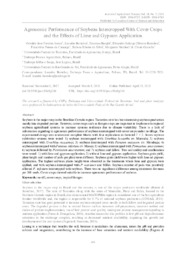Agronomic performance of soybean intercropped with cover crops and the effects of lime and Gypsum application.
Agronomic performance of soybean intercropped with cover crops and the effects of lime and Gypsum application.
Autoria: FERREIRA JÚNIOR, O. J.; BORTOLON, L.; BORGHI, E.; BORTOLON, E. S. O.; CAMARGO, F. P. de; SILVA, R. R. da; NICOLODI, M.; GIANELLO, C.
Resumo: Soybean is the major crop in the Brazilian Cerrado region. Tocantins state has been increasing soybean production mostly into degraded pasture. However, cover crops such as forages crops are important to implement in regional soybean agricultural systems to increase systems resilience due to climate variability. There is a lack of information regarding to agronomic performance of soybean intercropped with cover crops under no-tillage. The experimental design was randomized complete blocks with four replications in factorial 7 × 2. Seven soybean cultivation systems were tested: 1) soybean intercropped with Urochloa brizantha cv. Marandu; 2) soybean intercropped with Urochloa ruziziensis; 3) soybean intercropped with Panicum maximum cv. Mombaça; 4) soybean intercropped with Panicum infestans cv. Massai; 5) soybean intercropped with Pennisetum americanum; 6) soybean followed by Pennisetum americanum; and 7) soybean and fallow. Two soil acidity and amelioration were tested: 1) with lime and gypsum application; 2) without lime and gypsum application. Soybean grain yield, plant height and number of pods per plant were different. Soybean grain yield were higher with lime ad gypsum application. The highest soybean plants height were observed in the treatments where lime and gypsum were applied, and with soybean intercropped with P. maximun and Millet. Soybean number of pods was positively affected P. infestans intercropped with soybean. There was no significant difference among treatments for mass per 100 seeds. Cover crops showed suitable to increase agronomic performance of soybean.
Ano de publicação: 2018
Tipo de publicação: Artigo de periódico
Unidade: Embrapa Pesca e Aquicultura
Palavras-chave: Cover crops, Forrageira Tropical, Glycine Max, Gypsum, Limes, No-tillage, Planta de Cobertura, Plantio Direto, Soja, Soybeans, Tropical pastures
Observações
1 - Por padrão são exibidas publicações dos últimos 20 anos. Para encontrar publicações mais antigas, configure o filtro ano de publicação, colocando o ano a partir do qual você deseja encontrar publicações. O filtro está na coluna da esquerda na busca acima.
2 - Para ler algumas publicações da Embrapa (apenas as que estão em formato ePub), é necessário ter, no celular ou computador, um desses softwares gratuitos. Sistemas Android: Google Play Livros; IOS: iBooks; Windows e Linux: software Calibre.
Acesse outras publicações
Acesse a Base de Dados da Pesquisa Agropecuária (BDPA) para consultar o acervo completo das bibliotecas da Embrapa.

